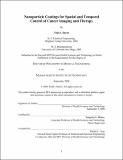| dc.contributor.advisor | Sangeeta N. Bhatia. | en_US |
| dc.contributor.author | Harris, Todd J | en_US |
| dc.contributor.other | Harvard University--MIT Division of Health Sciences and Technology. | en_US |
| dc.date.accessioned | 2009-06-25T20:35:46Z | |
| dc.date.available | 2009-06-25T20:35:46Z | |
| dc.date.copyright | 2008 | en_US |
| dc.date.issued | 2008 | en_US |
| dc.identifier.uri | http://hdl.handle.net/1721.1/45625 | |
| dc.description | Thesis (Ph. D.)--Harvard-MIT Division of Health Sciences and Technology, 2008. | en_US |
| dc.description | This electronic version was submitted by the student author. The certified thesis is available in the Institute Archives and Special Collections. | en_US |
| dc.description | Includes bibliographical references. | en_US |
| dc.description.abstract | Nature has evolved elegant strategies to temporally and spatially control protein activity, including the synthesis of subunits that require assembly for function, the incorporation of pro-domains that require cleavage for activation, and the formation of inhibitory and stimulatory networks that continually hold enzyme activity in balance. While nanomaterials have been developed with a myriad of functions for sensing or delivering biomolecules, the incorporation of Nature's more sophisticated control strategies in nanoparticle systems has yet to be fully realized. Here, inspired by the biological motifs that control protein function, a series of nanoparticle coatings are developed that utilize bio-inspired strategies for temporal and spatial control, including emergent function through self-assembly, unveiling of latent properties in response to protease activation, and the integration of inhibitory and stimulatory protein interactions. Specifically: 1) Protease removable polymer coatings are developed that veil and unveil complementary iron-oxide nanoparticles, leading to enhanced MRI contrast from protease-activated nanoparticle self-assembly. 2) Prodomain nanoparticles are developed using removable coatings that veil nanoparticle-cell interactions, lengthen particle circulation times, increase tumor accumulation, and unveil nanoparticle surface domains upon cleavage by proteases in the tumor. 3) Removable coatings are adapted to poly (β-amino ester) gene delivery vectors using electrostatically adsorbed peptide linkers, enabling localized gene delivery to cancer cells expressing tumor-associated proteases. 4) Electrostatic coatings for gene delivery vectors are characterized and developed in vivo, leading to the identification of certain peptide-particle formulations that integrate stimulatory and inhibitory blood and cell surface interactions to achieve specific and effective organ-directed delivery. | en_US |
| dc.description.abstract | (cont) 5) Materials used for gene delivery are applied to siRNAs, demonstrating the potential use of these coatings strategies for gene silencing applications. In order to achieve effective cancer therapy nanoparticles must overcome a series of sequential obstacles including undisrupted passage through the blood, accumulation in the tumor, shuttling across intracellular boundaries, and therapeutic delivery inside the cell. In this work we demonstrate how spatially and temporally controlled nanoparticle coatings effectively surmount these multiple barriers to improve imaging and therapy of tumors. | en_US |
| dc.description.statementofresponsibility | by Todd J. Harris. | en_US |
| dc.format.extent | 145 leaves | en_US |
| dc.language.iso | eng | en_US |
| dc.publisher | Massachusetts Institute of Technology | en_US |
| dc.rights | M.I.T. theses are protected by
copyright. They may be viewed from this source for any purpose, but
reproduction or distribution in any format is prohibited without written
permission. See provided URL for inquiries about permission. | en_US |
| dc.rights.uri | http://dspace.mit.edu/handle/1721.1/7582 | en_US |
| dc.subject | Harvard University--MIT Division of Health Sciences and Technology. | en_US |
| dc.title | Nanoparticle coatings for spatial and temporal control of cancer imaging and therapy | en_US |
| dc.type | Thesis | en_US |
| dc.description.degree | Ph.D. | en_US |
| dc.contributor.department | Harvard University--MIT Division of Health Sciences and Technology | |
| dc.identifier.oclc | 320770223 | en_US |
